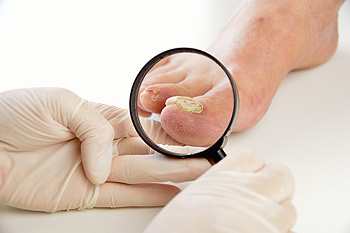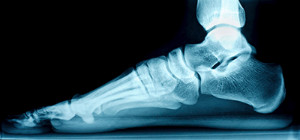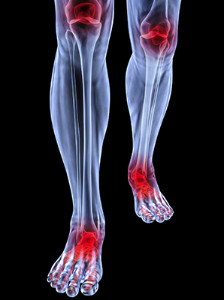Connect With Us
Blog
Items filtered by date: August 2020
Fungal Nails 101
 When fungus gets under the toenail, it begins to feed on the keratin that makes up the nail. While an infected nail is easy to treat in the early stages, the infection becomes more and more difficult to manage as it grows. Common risk factors for developing a fungal nail infection may include trauma, poor hygiene, sweating, and walking barefoot in moist environments. Toenails that have been infected by a fungus will become brittle, crumble, and turn yellowish in color. Treatments for infected toenails can include topical medications, oral medications, and laser treatment. If you believe that you are afflicted with a toenail fungus, it is important that you consult with a podiatrist for proper care and treatment.
When fungus gets under the toenail, it begins to feed on the keratin that makes up the nail. While an infected nail is easy to treat in the early stages, the infection becomes more and more difficult to manage as it grows. Common risk factors for developing a fungal nail infection may include trauma, poor hygiene, sweating, and walking barefoot in moist environments. Toenails that have been infected by a fungus will become brittle, crumble, and turn yellowish in color. Treatments for infected toenails can include topical medications, oral medications, and laser treatment. If you believe that you are afflicted with a toenail fungus, it is important that you consult with a podiatrist for proper care and treatment.
If left untreated, toenail fungus may spread to other toenails, skin, or even fingernails. If you suspect you have toenail fungus it is important to seek treatment right away. For more information about treatment, contact Philip K. Schrumpf, DPM of Active Feet Clinic. Our doctor can provide the care you need to keep you pain-free and on your feet.
Symptoms
- Warped or oddly shaped nails
- Yellowish nails
- Loose/separated nail
- Buildup of bits and pieces of nail fragments under the nail
- Brittle, broken, thickened nail
Treatment
If self-care strategies and over-the-counter medications does not help your fungus, your podiatrist may give you a prescription drug instead. Even if you find relief from your toenail fungus symptoms, you may experience a repeat infection in the future.
Prevention
In order to prevent getting toenail fungus in the future, you should always make sure to wash your feet with soap and water. After washing, it is important to dry your feet thoroughly especially in between the toes. When trimming your toenails, be sure to trim straight across instead of in a rounded shape. It is crucial not to cover up discolored nails with nail polish because that will prevent your nail from being able to “breathe”.
In some cases, surgical procedure may be needed to remove the toenail fungus. Consult with your podiatrist about the best treatment options for your case of toenail fungus.
If you have any questions, please feel free to contact our office located in Missoula, MT . We offer the newest diagnostic and treatment technologies for all your foot care needs.
What Are Flexible Flat Feet?
 The term “flexible flat feet” refers to one of the most common types of flat feet. People with this condition have no visible arches when they are standing, but do have visible arches when they aren’t. This condition usually begins in childhood and continues into the adult years, getting progressively worse over time. The tendons and ligaments of the arch may eventually stretch or tear, becoming inflamed and painful. The typical symptoms of flexible flat feet include pain in the heel, arch, or ankle, feet that roll inward when you walk, pain along the shin, and a general aching or tiredness in the feet or legs. There are a variety of treatment options available for this condition, such as orthotic devices, or activity and shoe modifications. For more information about flexible flat feet, please consult with a podiatrist.
The term “flexible flat feet” refers to one of the most common types of flat feet. People with this condition have no visible arches when they are standing, but do have visible arches when they aren’t. This condition usually begins in childhood and continues into the adult years, getting progressively worse over time. The tendons and ligaments of the arch may eventually stretch or tear, becoming inflamed and painful. The typical symptoms of flexible flat feet include pain in the heel, arch, or ankle, feet that roll inward when you walk, pain along the shin, and a general aching or tiredness in the feet or legs. There are a variety of treatment options available for this condition, such as orthotic devices, or activity and shoe modifications. For more information about flexible flat feet, please consult with a podiatrist.
Flatfoot is a condition many people suffer from. If you have flat feet, contact Philip K. Schrumpf, DPM from Active Feet Clinic. Our doctor will treat your foot and ankle needs.
What Are Flat Feet?
Flatfoot is a condition in which the arch of the foot is depressed and the sole of the foot is almost completely in contact with the ground. About 20-30% of the population generally has flat feet because their arches never formed during growth.
Conditions & Problems:
Having flat feet makes it difficult to run or walk because of the stress placed on the ankles.
Alignment – The general alignment of your legs can be disrupted, because the ankles move inward which can cause major discomfort.
Knees – If you have complications with your knees, flat feet can be a contributor to arthritis in that area.
Symptoms
- Pain around the heel or arch area
- Trouble standing on the tip toe
- Swelling around the inside of the ankle
- Flat look to one or both feet
- Having your shoes feel uneven when worn
Treatment
If you are experiencing pain and stress on the foot you may weaken the posterior tibial tendon, which runs around the inside of the ankle.
If you have any questions please feel free to contact our office located in Missoula, MT . We offer the newest diagnostic and treatment technologies for all your foot and ankle needs.
Childhood Obesity Can Alter Feet
 The feet are the base of the body, supporting the body’s entire weight day after day. Because of this, it should not come as a surprise that body weight can affect the feet. Previous research has demonstrated that being overweight or obese puts more pressure and strain on the feet and can increase the risk of foot pain in adults. Now, studies are showing that these findings apply to children as well. A recent study comparing the foot characteristics of normal-weight, overweight, and obese children under the age of 12 found that the overweight and obese children had greater pressure exerted on their feet and were more likely to have flattened arches than their normal-weight counterparts. This may put the overweight and obese children at a higher risk of foot pain. If your child is experiencing foot pain, it is recommended that you see a podiatrist.
The feet are the base of the body, supporting the body’s entire weight day after day. Because of this, it should not come as a surprise that body weight can affect the feet. Previous research has demonstrated that being overweight or obese puts more pressure and strain on the feet and can increase the risk of foot pain in adults. Now, studies are showing that these findings apply to children as well. A recent study comparing the foot characteristics of normal-weight, overweight, and obese children under the age of 12 found that the overweight and obese children had greater pressure exerted on their feet and were more likely to have flattened arches than their normal-weight counterparts. This may put the overweight and obese children at a higher risk of foot pain. If your child is experiencing foot pain, it is recommended that you see a podiatrist.
Obesity has become very problematic at this point in time and can have extremely negative effects on the feet. If you’re an obese individual and are concerned about your feet, contact Philip K. Schrumpf, DPM from Active Feet Clinic. Our doctor can provide the care you need to keep you pain-free and on your feet.
Obesity and Your Feet
Since your feet are what support your entire weight when standing, any additional weight can result in pain and swelling. Being overweight is one of the main contributors to foot complications.
Problems & Complications
Extra Weight – Even putting on just a few extra pounds could create serious complications for your feet. As your weight increases, your balance and body will shift, creating new stresses on your feet. This uneven weight distribution can cause pain, even while doing the simplest tasks, such as walking.
Diabetes – People who are overweight are at serious risk of developing type-2 diabetes, which has a drastic impact on the health of your feet. As you get older, your diabetes might worsen, which could lead to loss of feeling in your feet, sores, and bruises. You could also become more prone to various infections.
Plantar fasciitis – Pressure and stress that is placed on muscles, joints, and tendons can trigger plantar fasciitis, which is an inflammation of tissue that forms along the bottom of the foot.
If you have any questions please feel free to contact our office located in Missoula, MT . We offer the newest diagnostic and treatment technologies for all your foot and ankle needs.
Arthritis Can Cause Pain in the Feet and Ankles
Rheumatoid Arthritis Is Associated With Many Foot Conditions
 Rheumatoid arthritis is an autoimmune condition that causes inflammation in and damage to the joints. This condition tends to begin in the smaller joints of the hands and feet. Because of this, rheumatoid arthritis is often associated with a variety of foot conditions. Some of these include heel pain, bunions, hammertoes, flat feet, corns, and calluses. If you have rheumatoid arthritis and experience problems with your feet, it is recommended that you consult with a podiatrist. Receiving treatment can help reduce inflammation, relieve pain, and maintain mobility.
Rheumatoid arthritis is an autoimmune condition that causes inflammation in and damage to the joints. This condition tends to begin in the smaller joints of the hands and feet. Because of this, rheumatoid arthritis is often associated with a variety of foot conditions. Some of these include heel pain, bunions, hammertoes, flat feet, corns, and calluses. If you have rheumatoid arthritis and experience problems with your feet, it is recommended that you consult with a podiatrist. Receiving treatment can help reduce inflammation, relieve pain, and maintain mobility.
Because RA affects more than just your joints, including the joints in your feet and ankles, it is important to seek early diagnosis from your podiatrist if you feel like the pain in your feet might be caused by RA. For more information, contact Philip K. Schrumpf, DPM of Active Feet Clinic. Our doctor will assist you with all of your podiatric concerns.
What Is Rheumatoid Arthritis?
Rheumatoid Arthritis (RA) is an autoimmune disorder in which the body’s own immune system attacks the membranes surrounding the joints. Inflammation of the lining and eventually the destruction of the joint’s cartilage and bone occur, causing severe pain and immobility.
Rheumatoid Arthritis of the Feet
Although RA usually attacks multiple bones and joints throughout the entire body, almost 90 percent of cases result in pain in the foot or ankle area.
Symptoms
- Swelling and pain in the feet
- Stiffness in the feet
- Pain on the ball or sole of feet
- Joint shift and deformation
Diagnosis
Quick diagnosis of RA in the feet is important so that the podiatrist can treat the area effectively. Your doctor will ask you about your medical history, occupation, and lifestyle to determine the origin of the condition. Rheumatoid Factor tests help to determine if someone is affected by the disease.
If you have any questions please feel free to contact our office located in Missoula, MT . We offer the newest diagnostic and treatment technologies for all your foot and ankle needs.
Causes and Symptoms of Tarsal Tunnel Syndrome
 Tarsal tunnel syndrome is a condition caused by the compression of the tibial nerve in your ankle. The tibial nerve can become compressed as the result of trauma, such as a fall, or from overuse. Tarsal tunnel syndrome might also arise as a complication following an ankle sprain or other lower limb injury, or following surgery. People who are diagnosed with diabetes or rheumatoid arthritis are at an increased risk of developing tarsal tunnel syndrome. The typical symptoms of this condition are a tingling, pins and needles sensation along the inner side of the ankle or foot, pain during extended periods of walking or standing, a burning sensation in the foot at night, and weakness in the muscles that bend the toes. If you are experiencing any symptoms of tarsal tunnel syndrome, it is suggested that you consult with a podiatrist.
Tarsal tunnel syndrome is a condition caused by the compression of the tibial nerve in your ankle. The tibial nerve can become compressed as the result of trauma, such as a fall, or from overuse. Tarsal tunnel syndrome might also arise as a complication following an ankle sprain or other lower limb injury, or following surgery. People who are diagnosed with diabetes or rheumatoid arthritis are at an increased risk of developing tarsal tunnel syndrome. The typical symptoms of this condition are a tingling, pins and needles sensation along the inner side of the ankle or foot, pain during extended periods of walking or standing, a burning sensation in the foot at night, and weakness in the muscles that bend the toes. If you are experiencing any symptoms of tarsal tunnel syndrome, it is suggested that you consult with a podiatrist.
Tarsal tunnel syndrome can be very uncomfortable to live with. If you are experiencing tarsal tunnel syndrome, contact Philip K. Schrumpf, DPM of Active Feet Clinic. Our doctor can provide the care you need to keep you pain-free and on your feet.
Tarsal Tunnel Syndrome
Tarsal tunnel syndrome, which can also be called tibial nerve dysfunction, is an uncommon condition of misfiring peripheral nerves in the foot. The tibial nerve is the peripheral nerve in the leg responsible for sensation and movement of the foot and calf muscles. In tarsal tunnel syndrome, the tibial nerve is damaged, causing problems with movement and feeling in the foot of the affected leg.
Common Cause of Tarsal Tunnel Syndrome
- Involves pressure or an injury, direct pressure on the tibial nerve for an extended period of time, sometimes caused by other body structures close by or near the knee.
- Diseases that damage nerves, including diabetes, may cause tarsal tunnel syndrome.
- At times, tarsal tunnel syndrome can appear without an obvious cause in some cases.
The Effects of Tarsal Tunnel Syndrome
- Different sensations, an afflicted person may experience pain, tingling, burning or other unusual sensations in the foot of the affected leg.
- The foot muscles, toes and ankle become weaker, and curling your toes or flexing your foot can become difficult.
- If condition worsens, infections and ulcers may develop on the foot that is experiencing the syndrome.
A physical exam of the leg can help identify the presence of tarsal tunnel syndrome. Medical tests, such as a nerve biopsy, are also used to diagnose the condition. Patients may receive physical therapy and prescriptive medication. In extreme cases, some may require surgery.
If you have any questions please feel free to contact our office located in Missoula, MT . We offer the newest diagnostic and treatment technologies for all your foot and ankle needs.
Blog Archives
- August 2024
- July 2024
- June 2024
- May 2024
- April 2024
- March 2024
- February 2024
- January 2024
- December 2023
- November 2023
- October 2023
- September 2023
- August 2023
- July 2023
- June 2023
- May 2023
- April 2023
- March 2023
- February 2023
- January 2023
- December 2022
- November 2022
- October 2022
- September 2022
- August 2022
- July 2022
- June 2022
- May 2022
- April 2022
- March 2022
- February 2022
- January 2022
- December 2021
- November 2021
- October 2021
- September 2021
- August 2021
- July 2021
- June 2021
- May 2021
- April 2021
- March 2021
- February 2021
- January 2021
- December 2020
- November 2020
- October 2020
- September 2020
- August 2020
- July 2020
- June 2020
- May 2020
- April 2020
- March 2020
- February 2020
- January 2020
- December 2019
- November 2019
- October 2019
- September 2019
- August 2019
- July 2019
- June 2019
- May 2019
- April 2019
- March 2019

